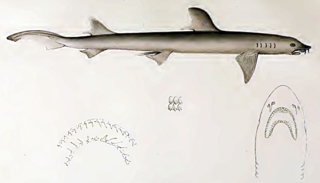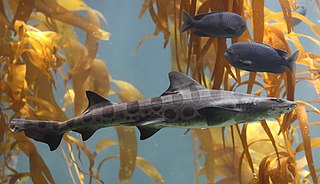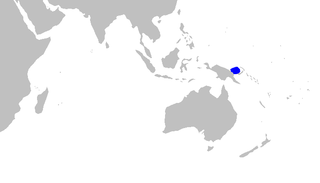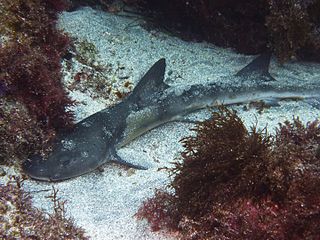
The Iago sparrow, also known as the Cape Verde or rufous-backed sparrow, is a passerine bird of the sparrow family Passeridae. It is endemic to the Cape Verde archipelago, in the eastern Atlantic Ocean near western Africa. Females and young birds have brown plumage with black marks above, and a dull grey underside, and are distinguished from other species of sparrow by their large, distinct supercilium. Males have a brighter underside and bold black and chestnut stripes on their head. At 12.5–13 centimetres (4.9–5.1 in) long, it is a smaller sparrow. This bird's vocalisations are mostly variations on its chirp, which differ somewhat between males and females.

Mustelus also known as the smooth-hounds is a genus of sharks in the family Triakidae. The name of the genus comes from the Latin word mustela, meaning weasel. It should not be confused with the genus name Mustela, which is used for weasels.

The barbeled houndshark is a species of ground shark and the only member of the family Leptochariidae. This demersal species is found in the coastal waters of the eastern Atlantic Ocean from Mauritania to Angola, at depths of 10–75 m (33–246 ft). It favors muddy habitats, particularly around river mouths. The barbeled houndshark is characterized by a very slender body, nasal barbels, long furrows at the corners of the mouth, and sexually dimorphic teeth. Its maximum known length is 82 cm (32 in).

Triakis is a genus of houndsharks in the family Triakidae. The name comes from the Greek word τρι, tri meaning "three", and the Latin word acis meaning "sharp" or "pointed", in reference to the three-pointed teeth of these sharks.

The whiskery shark is a species of houndshark in the family Triakidae, and the only member of its genus. This common shark inhabits the Australian continental shelf from Western Australia to the Bass Strait, to a depth of 220 m (720 ft). It is demersal in habits and prefers rocky and vegetated habitats. Stout-bodied and almost "humpbacked" in form, the whiskery shark can be distinguished from all other members of its family by the presence of long nasal barbels. Its two moderately large dorsal fins are roughly equal in size. It is brownish gray above and lighter below, with a pattern of darker saddles and blotches in younger sharks. This species reaches 1.6 m (5.2 ft) in length.

The sailback houndshark is a houndshark of the family Triakidae, and the only member of the genus Gogolia. It is found in the deep waters of continental shelf off northern Papua New Guinea. Only one specimen has been found, at a depth of 73 m. It measured 74 cm in length. The reproduction of this shark is ovoviviparous.

The blacktip tope, also known as pencil shark or blacktip topeshark, is a houndshark of the family Triakidae, and the only member of the genus Hypogaleus. It is found in the deep waters of the continental shelf in the Indo-West Pacific, from East Africa to Japan, at depths between 40 and 230 m. It can grow up to a length of 1.27 m.

The flapnose houndshark is a houndshark of the family Triakidae, and the only member of the genus Scylliogaleus. It is found in the waters off subtropical South Africa, in the western Indian Ocean between latitudes 27 and 33°S.

Hemitriakis is a genus of houndsharks in the family Triakidae.

The sharpfin houndshark is a houndshark of the family Triakidae. Only two specimens have been found, both in the coastal waters of Ecuador, the longest one being 1.02 m in length. The reproduction of this houndshark is ovoviviparous.

The spotted houndshark, Triakis maculata, is a houndshark of the family Triakidae found in tropical waters in the eastern Pacific Ocean off the coast of South America. It usually grows to a length around 180 centimetres (71 in). The reproduction of this houndshark is ovoviviparous, with a litter of 14 pups being found in one female with a birth size of 30 to 40 centimetres. Their diet is believed to consist mainly of crustaceans.

The sharptooth houndshark, or spotted gully shark is a species of houndshark in the family Triakidae found in shallow inshore waters from southern Angola to South Africa. Favoring sandy areas near rocky reefs and gullies, it is an active-swimming species that usually stays close to the bottom. This robust shark reaches 1.7 m (5.6 ft) in length and has characteristically large, rounded fins; the pectoral fins in particular are broad and sickle-shaped in adults. It also has a short, blunt snout and long furrows around its mouth. This species is gray or bronze in color above, with variable amounts of black spotting.

The banded houndshark is a species of houndshark in the family Triakidae, common in the northwestern Pacific Ocean from the southern Russian Far East to Taiwan. Found on or near the bottom, it favors shallow coastal habitats with sandy or vegetated bottoms, and also enters brackish water. This shark reaches 1.5 m (4.9 ft) in length. It has a short, rounded snout and mostly narrow fins; the pectoral fins are broad and triangular, and the trailing margin of the first dorsal fin is almost vertical. It is gray above and lighter below; younger sharks have darker saddles and dots, which fade with age.

The deepwater sicklefin houndshark or the darksnout houndshark, is a houndshark of the family Triakidae. It is found in the western central Pacific, in the Coral Sea off Queensland and in the waters off New Caledonia.
The Indonesian houndshark is a species of houndshark in the genus Hemitriakis. It is a tropical houndshark, known from the eastern Indonesian islands of Bali and Lombok, in the Indian Ocean. It was described by William T. White, Leonard J.V. Compagno, and Dharmadi in 2009. Females give birth to live young, with no placenta or yolk sac, and can have between six and 11 pups in one litter. When born, the pups measure 28-30 cm long. At first maturity, the houndsharks measure 90 cm, and males can go on to reach a maximum length of 120 cm, while females can reach a maximum length of 115 cm.
Mustelus mangalorensis also known as the Mangalore houndshark is a species of houndshark in the Triakidae family, found in Indian waters.















